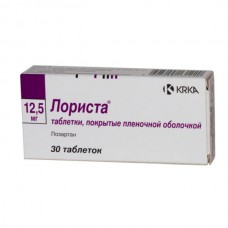Expiration date: 05/2026
The composition and form of issue:
Tablets, film-coated. 1 tablet contains losartan potassium 12.5, 25, 50 or 100 mg
excipients: cellactose (mixture of lactose monohydrate and cellulose) starch pregelatinized corn starch microcrystalline silica colloidal anhydrous magnesium stearate
shell: hypromellose talc propylene glycol quinoline yellow dye (E104) — only for tablets, 12.5 and 25 mg titanium dioxide (E171)
in the package contour 7, 10 or 14 PCs the paper cartons 2 package (7 pieces) 1 package (14 PCs) 3, 6, 9 packs (10 PCs.).
Description pharmaceutical form:
Pills 12.5 mg: oval, slightly biconvex tablets, film-coated from light-yellow to yellow color, with facet.
Pills 25 mg: oval, slightly biconvex tablets, film-coated, yellow color, scored on one side and the chamfer.
Tablets 50 mg: round, slightly biconvex tablets, film-coated, white, scored on one side, chamfered.
Pills 100 mg: oval, slightly biconvex tablets, film-coated, white.
Pharmacokinetics:
Losartan is well absorbed from the gastrointestinal tract. Undergoes significant metabolism when "first pass" through the liver, forming the active metabolite (EXP-3174) carboxylato acid and other inactive metabolites. Bioavailability is approximately 33%. Taking the drug with food has no clinically significant effect on its serum concentration. Tmax — 1 h after ingestion, but its active metabolite (EXP-3174), 3-4 p.m.
More than 99% of losartan and EXP-3174 is associated with blood plasma proteins, mainly to albumin. The volume of distribution of losartan is 34 L. Very poorly crosses the GEB.
Losartan is metabolized to the active (EXP-3174) of metabolite (14%) and the inactive, including 2 major metabolites, formed by hydroxylation of the butyl chain group, and a less significant metabolite — N-2-glucuronide tetrazol.
Plasma clearance of losartan and its active metabolite is approximately 10 ml/s (600 ml/min) and 0.83 ml/s (50 ml/min), respectively. Renal clearance of losartan and its active metabolite is about 1.23 ml/s (74 ml/min) and of 0.43 ml/s (26 ml/min). T1/2 of losartan and the active metabolite is 2 h and 6-9 h respectively. It is excreted mainly in the bile — 58%, renal — 35%.
Description pharmacological action:
Losartan is a selective antagonist of the angiotensin II receptor (type AT1) for intake of non-protein nature.
In vitro and In vivo losartan and its biologically active carboxyl metabolite (EXP-3174) block all physiologically relevant effects of angiotensin II on AT1-receptors.
Losartan indirectly causes activation of the AT2 receptors by increasing levels of angiotensin II.
Losartan does not inhibit the activity of kininase II enzyme, which is involved in the metabolism of bradykinin.
Reduces PR, blood pressure is a "small" circulation reduces afterload, has a diuretic effect. Prevents the development of myocardial hypertrophy, increases tolerance to physical load in patients with chronic heart failure (CHF). Taking losartan once a day results in statistically significant reduction in SBP and DBP. Losartan uniformly controls the pressure throughout the day, while the antihypertensive effect corresponds to the natural circadian rhythm. The decrease in blood pressure at the end of the action dose was approximately 70-80% of the effect at the peak of drug action, 5-6 h after administration. The syndrome is not observed also the losartan has no clinically significant effect on heart rate.
Losartan effective in men and women, and the elderly ( over 65 years) and younger patients (under 65 years).
Indications:
- hypertension
- reducing the risk of stroke in patients with hypertension and left ventricular hypertrophy
- chronic heart failure (in combination therapy, intolerance or failure of therapy with ACE inhibitors)
- protection of renal function in patients with diabetes mellitus type 2 with proteinuria to reduce proteinuria, reduce progression of kidney damage, reduce the risk of end-stage (prevention of need for dialysis, the probability of an increase in creatinine in serum) or death.
Contraindications:
Hypersensitivity to losartan or to other components of the drug, hypotension, hyperkalemia, dehydration, pregnancy and lactation, age under 18 years (effectiveness and safety have not been established), lactose intolerance, galactosemia or malabsorption syndrome glucose/galactose.
With caution: hepatic and/or renal failure, reduced BCC, violations vodno-elektrolitnogo balance, bilateral renal artery stenosis or stenosis of the artery to a solitary kidney.
Application of pregnancy and breast-feeding:
Data on the use of losartan during pregnancy not. Renal perfusion the fetus, which depends on the development of the renin-angiotensin system, begins to function in the III trimester of pregnancy. Risk to the fetus increases when taking losartan in II and III trimestrah. During the pregnancy the therapy with losartan should be stopped immediately.
No data on the allocation of losartan into breast milk. Therefore, to solve the issue of termination of breastfeeding or cancellation of therapy with losartan, given its importance to the mother.
Side effects:
In most cases Lorista well tolerated, side effects are weak and transient in nature and do not require discontinuation of the drug.
From the side of blood system: rarely — anemia, a disease Henoch-Schonlein purpura.
Allergic reactions: less than 1% — urticaria, skin rash, itching, angioedema (including swelling of the larynx and tongue, causing airway obstruction and/or swelling of the face, lips, throat).
CNS and sensory organs: with a frequency of 1% or more of dizziness, asthenia, headache, fatigue, insomnia, less than 1% — anxiety, insomnia, drowsiness, memory disorders, peripheral neuropathy, paresthesia, hypoesthesia, migraine, tremor, ataxia, depression, syncope, tinnitus, taste disturbance, blurred vision, conjunctivitis.
Of the cardiovascular system: orthostatic hypotension (dose related), palpitation, Tahi - or bradycardia, arrhythmia, angina, vasculitis.
With the genitourinary system: with a frequency of less than 1% — an imperative urge to urinate, urinary tract infections, impaired renal function, decreased libido, impotence.
The respiratory system: with a frequency of 1% and higher, nasal congestion, cough*, infections of the upper respiratory tract, pharyngitis, dyspnea, bronchitis, swelling of the nasal mucosa.
From the digestive tract: with a frequency of 1% or more — nausea, diarrhea*, dyspepsia*, abdominal pain less than 1% — anorexia, dry mouth, toothache, vomiting, flatulence, gastritis, constipation, hepatitis, abnormal liver function.
From the skin: with a frequency of less than 1% — dry skin, erythema, photosensitivity, increased sweating, alopecia.
From the side of musculoskeletal system: with a frequency of 1% or more convulsion, myalgia*, back pain, chest, legs less than 1% — arthralgia, arthritis, shoulder pain, knee, fibromyalgia.
Laboratory parameters: hyperkalemia rarely moderate increase in level of urea and creatinine in blood serum, very rarely — increased activity of liver enzymes, hyperbilirubinemia.
Other: gout.
The symbol "*" marked side effects, the incidence of which is comparable to placebo.
Drug interactions:
There were no clinically significant drug interactions with hydrochlorothiazide, digoxin, indirect antikoagulyantami, cimetidine, phenobarbital, ketoconazole and erythromycin. During simultaneous use of rifampicin and fluconazole was observed a decrease in the level of the active metabolite of losartan potassium. The clinical implications of this phenomenon are not known.
Concomitant use of potassium-sparing diuretics (e.g. spironolactone, triamterene, amiloride) and potassium supplements increases the risk of hyperkalemia.
When co-administered with non-steroidal anti-inflammatory drugs (NSAIDs), including selective COX-2 inhibitors may decrease effect of antihypertensives.
If losartan is assigned in conjunction with thiazide diuretics, decrease in blood pressure is additive.
Do (mutually) effect of other antihypertensive agents (diuretics, beta - adrenoblokatorov, simpatolitikov).
Method of application and dose:
Inside, regardless of meals.
Multiplicity of reception — 1 time per day.
Hypertension: average daily dose is 50 mg. the Maximal antihypertensive effect is attained within 3-6 weeks of therapy. Some patients can achieve a more pronounced effect by increasing the dose up to 100 mg/day in 2 or in 1 reception.
In patients receiving high doses of diuretics, it is recommended to start treatment with Lorista 25 mg/day 1 reception.
In elderly patients, and patients with impaired renal function, including patients on hemodialysis, does not require initial dose adjustment.
Do not need to adjust the dose in elderly patients or patients with impaired renal function, including patients on hemodialysis.
Patients with impaired liver function should be assigned lower doses of the drug.
Congestive heart failure: initial dose is 12.5 mg/day 1 reception. To achieve the usual maintenance dose 50 mg/day, the dose should be increased gradually, at intervals of one week (for example, 12,5, 25 or 50 mg in single dose per day). Lorista is usually administered in combination with diuretics and cardiac glycosides.
The dose should be increased according to the following scheme:
1st week (1-7 day) — 1 table. 12.5 mg/day.
2nd week (8-14 day) — 1 table. 25 mg/day.
3rd week (15-21 day) — 1 table. 50 mg/day.
4th week (22nd to 28th day) — 1 table. 50 mg/day.
Reducing the risk of stroke in patients with hypertension and left ventricular hypertrophy: standard initial dose is Lorista 50 mg/day 1 reception. May be further added hydrochlorothiazide in low doses and/or dose was increased Lorista 100 mg/day.
Protection of kidneys in patients with diabetes mellitus type 2 with proteinuria: standard initial dose is Lorista 50 mg/day 1 reception. The dose may be increased to 100 mg/day, given decline in blood pressure.
Application in Pediatrics. The safety and efficacy of the drug in children has not been established.
Overdose:
Symptoms: expressed lower AD, tachycardia as a result of parasympathetic (vagal) stimulation may develop bradycardia.
Treatment: forced diuresis, symptomatic therapy. Hemodialysis is ineffective.
Special instructions:
In patients with reduced BCC (for example in the treatment with high doses of diuretics) may develop symptomatic hypotension. Before you start taking losartan it is necessary to eliminate the violations or initiating therapy with small doses.
In patients with light and moderate liver cirrhosis concentrations of losartan and its active metabolite in blood plasma after oral administration is higher than in healthy controls. Therefore, patients with liver diseases in history are advised therapy lower doses.
In patients with impaired renal function as with diabetes, and often develop electrolyte disturbances (hyperkalemia), which should be paid attention to. However, only in rare cases stop the treatment because of hyperkalemia. During treatment should regularly monitor the concentration of potassium in the blood, especially in elderly patients when impaired renal function.
Drugs acting on the renin-angiotensin system, can increase the content of urea and creatinine in blood serum in patients with bilateral or unilateral stenosis of the artery only kidneys. Changes in renal function may be reversible upon discontinuation of therapy. During treatment should regularly monitor the concentration of creatinine in serum, at equal intervals of time.
Effects on ability to drive and other mechanical devices. Data on the influence of losartan on ability to drive vehicles or other means are not available.
Lorista
(Losartan)
- Brand: KRKA









